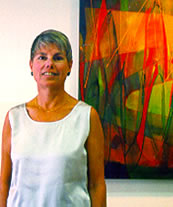sense out of that which is
not meant to.
Lynne Taetzsch has always been an artist. As a child growing up in New Jersey, she sculpted play dough, made holiday decorations and played with all kinds of craft projects. When she was old enough to get an allowance, she says, “I spent it all on art supplies”. She loved to work with paint, chalk, paper and brushes and she learned to, “achieve technical mastery of my tools.” In her early teens, she began to study and draw the intricacies she observed in nature.
She eventually began to draw and paint portraits of her family members as well as self-portraits - which captured her various up and down moods with sharp reality and stark colors.
Quietly depressed in her early teens, she comments, “I moved into my wild stage. I rode a wave from mania to depression, doing everything I could to stimulate the mania. Bored by high school, I quit after my junior year and got my G.E.D. in the summer.”
In the fall she was enrolled in Rutgers
University in Newark and signed up for a drawing class where she learned to,
“loosen up and use the larger gesture of my whole arm, instead of the
tight strokes of cramped fingers.”
She gradually developed a looser style which she describes as, “much
more expressive in terms of color and form.”
She attended the University of Southern California on a scholarship the following year and became interested in, ”...the surface of paintings and the flat two-dimensionality, play of planes, intricacies of texture and subtleties of tone." Her professor at USC asked, "Where did you learn to paint like that?"
Feeling restricted with, “... too many rules and the formality of USC,” Lynne applied to Cooper Union art school in New York City, which she describes as, “ ... my kind of place where sloppy t-shirts and jeans were the norm, and just about everyone there was acting up or acting out.” She further elaborated on the lifestyle there, saying, “We would take speed and drink coffee, talking each other to death. We would build light and sound machines, projects we set on fire, constructions to tickle the senses. We would wander around Washington Square, sketching the men playing chess or sleeping on benches. We would spend days walking uptown, checking out the galleries and museums." She said her vision was changed forever by New York's abstract expressionists - Jackson Pollock, Willem de Kooning, Hans Hoffman, Helen Frankenthaler, Fanz Kline, Robert Motherwell, and Mark Rothko.
“At that time,” she recalls, “ the popular notion of a serious artist was likely to be an alienated, unshaven, drink-and-drug- driven rebel who trampled on tradition, howled at the absurdity of life, and looked down contemptibly on middle-class values and low-brow culture. I identified with this male icon of the beat generation, and strove to excise myself from any identification with mainstream morality, values, and institutions. I wore black, drove a motorcycle, and let the dust balls accumulate in my pad." Her favorite colors to paint with at that time were red and black, and she states, “No one would call my paintings at that time decorative or pretty.”
Her artist skills were further developed at Cooper Union, as she studied calligraphy, architectonics, one and two dimensional design, life drawing, and painting.
Her painting teacher, Charles Side helped her understand, “... what I was about and that I no longer needed art school.” “In his class, I added collage materials to oil paint and that process intensified my sense of composition, leading my art to its non-objective stage.”
Lynne believes all art is abstract in the sense that, ”...it moves away from reality to some degree.” Non-objective art, she says, ”...however, does not begin with the world at all. It has no reference point.”
Lynne says her life has taken a lot of turns since her college days. She moved back and forth from the east to the west coasts several times and is now settled in the Finger Lakes region of New York State. Her experience has also been varied - she has worked as a secretary, a writer, an editor, a publisher, a junior-high English and math teacher, a business trainer and manager, a leather crafter, and a college professor. However, she always continued her painting as she tried out various jobs along the way. She has been painting full time in her studio in Ithaca, New York, since 2000.

Lynne eventually switched from oil paint to acrylics, which she found worked better because they dry quickly. Her painting style involves working on a painting over many days, adding layers that accumulate without totally eradicating the previous layers. She notes, “The process or action of the painting allows me to express my intentions through the motion of the brush or palette knife." She compares her painting process to jazz, explaining, "The heart of my art is improvisation.”
Lynne's paintings are exhibited in solo, group, and juried exhibitions throughout the United States.
Her art is available online at:
http://www.artbylt.com/buyart.htm
Lynne may be contacted at:
Edited
from information on
Lynne Taetzsch’s website:
www.artbylt.com/index.htm

